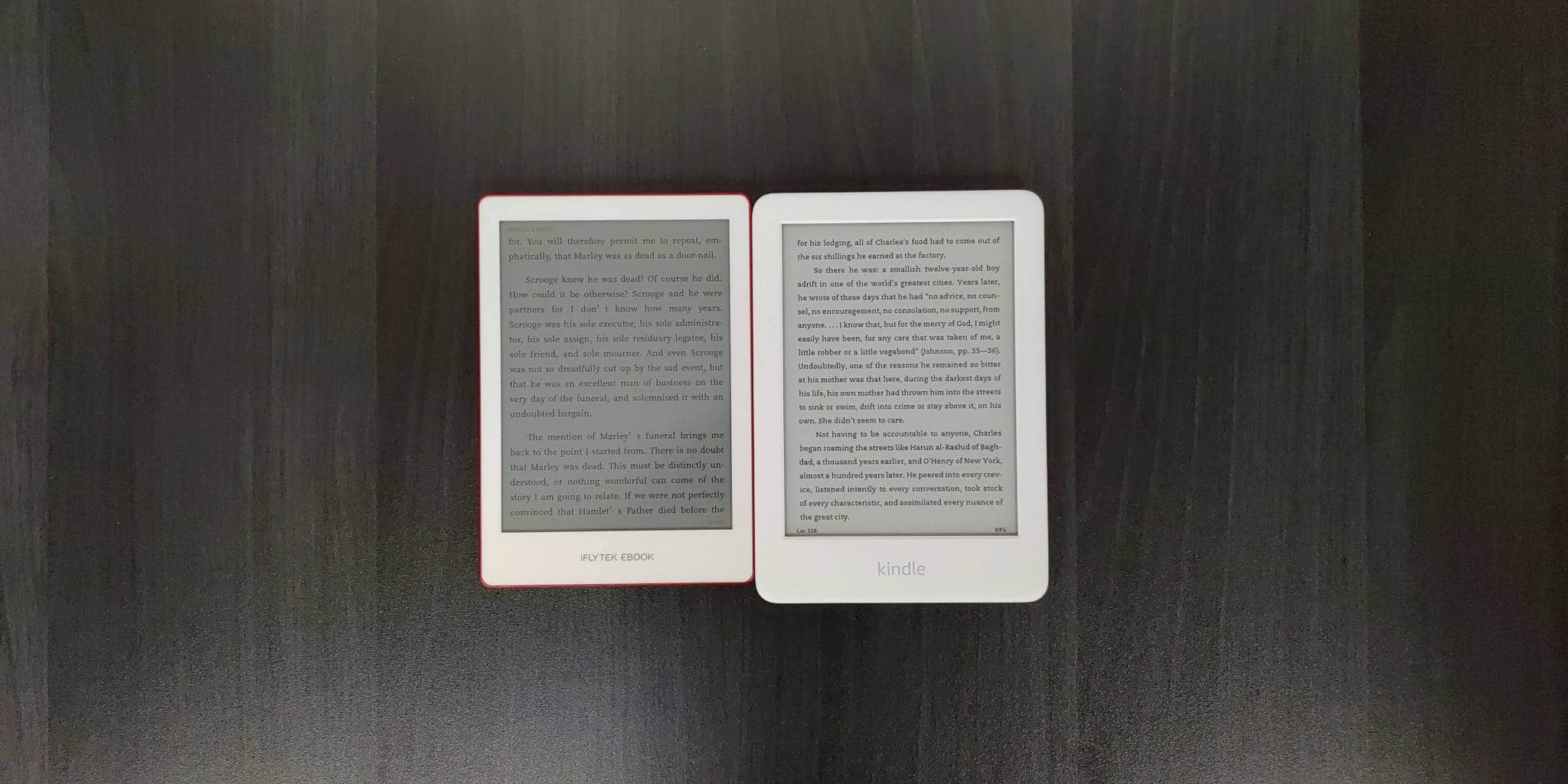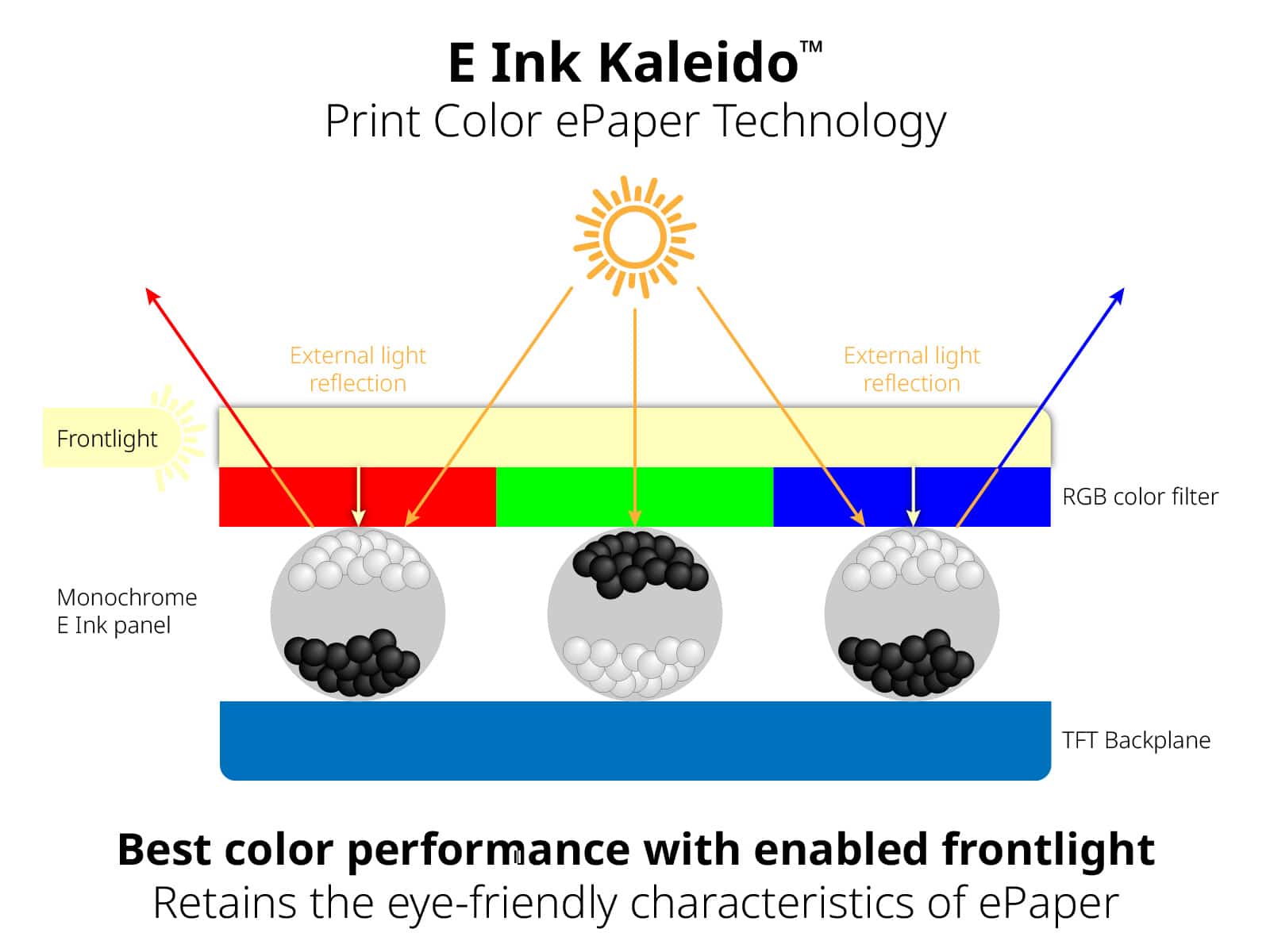
After around two years of development, E INK released their new color e-paper technology. They are calling it by two different names, Print Color E-paper and Kaleido. This technology provides 4,096 different colors and has its own RGB color filter array that is on top of the standard E INK Carta display. Many companies have disclosed to Good e-Reader about some limitations of this technology and we have noticed others during our own internal testing.
Kaleido e-paper can produce color for each pixel that is displayed on the screen. This includes red, green, blue, black or white. Colors can be combined to give you different colors or shades. The way it works is if you want light blue, blue will be toned down and white will be brighter. If you want orange, then yellow and red would be blended. An E Ink Kaleido Module is comprised of a TFT backplane, Ink layer (such as E INK Carta HD or E INK Mobius), Color Filter layer and Protective Sheet. There are some cases where e-reader companies also use a layer of glass.
E INK has told Good e-reader about the grayscale and color system. “This is simplest way to think of it. The B/W ePaper module is capable of producing 16 grayscale which is 2^4. E Ink Kaleido is a non-glass-based CFA comprised of RGB. Each of the RGB has 16 levels of intensity and so 2^4 x 3 = 4096 colors.”

There are some limitations of the technology that prospective companies who are thinking about developing a color e-reader or a color e-note in 2021. First of all, the Color Filter Array is always on and can never be turned off. It is impossible to create software based switches to turn color off, this means it is ever present.
The color filter array always being on creates some problems with the ebook reading experience. A typical six inch color e-reader will have an E INK Carta and a E INK Color layer. An ebook will be able to display text based fonts at 300 PPI, but the background is different than a typical B&W e-reader, such as the Amazon Kindle. A Kindle will have a pure grey background, a color e-reader with a pure black font. This is because a typical E INK screen will have black and white particles that are charged, black ones will be the text and white/black will create greys. A color e-reader that employs a CFA will have background colors as a gradient, the background will never be grey. This is because the color filter array produces colors in a small hexagons, since these are larger than individual pixels, you will see discoloration of the background. If you could turn the color filter array off in ebooks, or give a user an option to disable color, this would be great, but this is currently impossible to do.


The second problem with the current generation of color e-paper, is that the color filter array makes the screen darker, than an e-reader without one. You can easily read ebooks on the Kindle, during the day, without needing to turn the front-light on. Many people are reading at home now, due to the global pandemic. Not everyone is going to be reading outside, but inside. Lighting conditions are going to be darker than normal, but in a normal room with maybe one or two window blinds/curtains open, you can get away with reading a Kindle, without turning on the front-light.
A color e-reader, due to the color filter array, produces a darker screen, in the same room, you would actually need to turn the light on to display colors properly, say a color manga, PDF or the internet browser. But can you get away with just reading an ebook, without turning the light on? Well, yes, because the background is not bright grey, like a typical e-reader, but a few different colors being projected, in conjunction with the black text, you would always need the light on, even if is just a few notches on the slider bar.

I have noticed a few Chinese e-reader companies approaching color e-readers using the wrong front-light technology. iFlytek and iReader are both using around 24 LED lights, normally this would be excellent, but half of these lights are blue, so you basically will never get a pure white front-lit display, like you would on a Kindle, Kobo or Nook. In reviewing all of these devices, blue light tends to make the colors look more muted or washed out. The Pocketbook Color, Onyx Boox Poke 2 Color and the Hisense A5C and Hisense A5 Pro CC all use white LED lights, which is the way to go, to provide the best way to make colors display properly.

I think in order to construct a device that will provide the best user experience, taking into account the technical limitations of color e-paper, is to construct a dedicated digital note taking device, similar to the Sony Digital Paper.
Drawing in color has been the unicorn for many companies that have been chasing for awhile. Some have a UI option that will allow you to draw in RBG when editing a PDF file or drawing. Since the devices are just using black and white displays, it won’t display colors on the E INK screen, instead when you save the drawing and send it to your PC, that is when you will see colors. I believe a dedicated E-Note that just will allow you to view/edit PDF files, browse the internet and have a full color note taking experience and app support would be the way to go.

Good e-Reader has reviewed every single color e-reader and color smartphone currently available, aside from the Onyx Boox Poke 2 Color, since it was only available for a few hours before it was sold out. The non-uniform grey background color on ebooks and the darker screen, warranting the front-light to always be engaged are two of the big problems. Can this be solved or fixed? This is something E INK has to do on a screen and PCP level, they have to create a hardware switch, that can be controlled with software to turn the CFA on/off. This would solve all of the current problems, but E INK has confirmed they will not be making a revision to Kaleido at all in 2021, but they will be updating ACEP, which is geared towards digital signage.
Michael Kozlowski is the editor-in-chief at Good e-Reader and has written about audiobooks and e-readers for the past fifteen years. Newspapers and websites such as the CBC, CNET, Engadget, Huffington Post and the New York Times have picked up his articles. He Lives in Vancouver, British Columbia, Canada.
